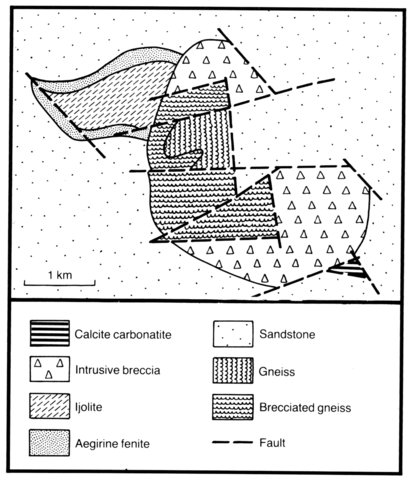stripes
Yraas is situated 30 km east of the Magan pluton at the watershed of the Magan and Ilya Rivers and was discovered in 1961. The country rocks are Riphean quartz sandstones of the Labaztach Series. The intrusion has a somewhat complicated outline with many fault-bounded contacts. Overall dimensions are about 5x2.7 km. It is a complex, multistage intrusive comprising two parts: the northwestern part consists substantially of ijolites and the southeastern part is represented essentially by intrusive breccias. The ijolites occupy a lens-like body of 0.5x1.7 km and are homogenous, medium-grained rocks composed mainly of nepheline and pyroxene (up to 90%) and lesser amounts of titanomagnetite, biotite-phlogopite and melanite (up to 10%). The accessory minerals are perovskite, titanite, apatite and calcite. In some places the ijolite contains blocks of weakly altered, coarse-grained melteigite and in places apatite-bearing aegirine fenite. Veins of pyroxene nelsonite, nepheline syenite and ore-bearing diopsidite are widespread. The intrusive breccia in the southeastern part of the complex occupies an area of 6.3 km2, contains numerous fragments of basement rocks, including two pyroxene and garnet plagio-gneisses, granulite and schist in a heterogenous nelsonite-carbonatite cement (apatite, magnetite and carbonate). Large basement blocks, up to hundreds of metres across, which are only partly displaced, have been found in the western part of the intrusive breccia. In the northern and eastern parts of the breccia body more than 50% of the gneisses have been transformed into carbonate-mica metasomatites. The Riphean quartz sandstone country rocks at the margin of the northwestern ijolite body have been metamorphosed with a 150-200 m wide zone of these rocks transformed into apatite-bearing aegirine fenites. Thus, the generation of the Yraas complex took place in five stages. The first three involved the successive emplacement of melteigite, ijolite and nepheline syenite, with fenitization of quartz sandstone. Finally, the intrusion of a fluid saturated in iron and phosphate (nelsonite) and carbonatite magmas triggered violent explosions within basement rocks and the formation of an intrusive explosion breccia.
EGOROV, L.S. 1969. The melilite rocks of the Maimecha-Kotui province. Nedra, Leningrad. 247 pp.
EGOROV, L.S. 1991. Ijolite carbonatite plutonism (case history of the Maimecha-Kotui complexes northern Siberia). Nedra, Leningrad. 260 pp.
PROCHOROVA, S.M., EVZIKOVA, N.Z. and MICHAILOVA, A.F. 1966. Phlogopite-bearing rocks of the Maimecha-Kotui province of ultrabasic alkaline rocks. Trudy Nauchno-Issledovatel'skogo Instituta Geologii Arktiki, Leningrad 140: 1-196.

